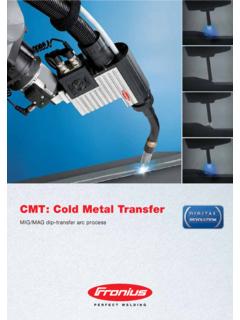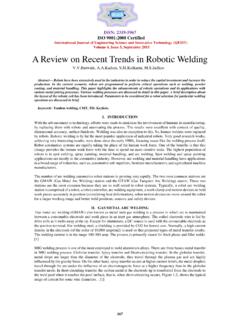Transcription of Tobias Manuel Vilas-Boas Rosado
1 1 Innovation in the MIG/MAG Process: Productivity analysis and Fume Emissions Tobias Manuel Vilas-Boas Rosado Abstract In a more competitive industry there is a constant search for new solutions, where a balance between productivity, quality, costs and safety is always present. In metal working companies where welding is significantly used the solution includes specific situations that this work approached. In this work new welding processes were studied, processes that are derivatives from the traditional MIG/MAG process: FastRoot, Surface Tension transfer (STT) and cold metal transfer (CMT).
2 These processes were analyzed through the study of its wave forms and through the study of the welds performed. This work approached two subjects, the productivity of the welding processes, and the fume formation that results from those welding processes. The present work pretends not only to study these processes but also show them in a more profound way, confirming at the same time some of the advantages associated with those welding processes. Keywords Welding; Productivity; MIG/MAG; FastRoot; CMT; STT; Welding Fume Formation Introduction The initial concept of the MIG/MAG welding process was first introduced in the 1920 s, but its first commercial appearance will only happen in the 1940 s [1], where an aluminum electrode was continuously fed and protected by a gas formed by 100% of Argon [2].
3 Only in 1951 with the introduction of a gas mixture of oxygen and argon, was possible to weld steel [3]. But only in the last 20 years this welding process began to dominate the industries of welded constructions [4]. Since it appeared in the late 1940 s until now, the MIG/MAG welding process suffered successive upgrades improving the productivity of the process and the safety of the welder. Those constant improvements were responsible for the great flexibility characteristic of this process, where a large range of materials and thicknesses can be welded.
4 The welding fumes that result from the MIG/MAG process have been studied since 1975 [5], specifically their nature and the factors that control the formation rate, as well as solutions to reduce the welding fumes produced. Just recently the Welding fumes began to gain more importance due to several law suits in the United States regarding illnesses that might be related to a long exposure to welding fumes. Some of those cases concern manganese [6]. Theoretical Background metal transfer The MIG/MAG welding process uses a consumable electrode, continuously fed to the weld pool.
5 If the fusion of the electrode is balanced by the electrode s speed towards the piece to weld, then the process will function in a continuous and stable manner. One of the ways to classify the transfer modes is dividing them into two groups [11]: free flight transfer dip transfer (short circuit) 2 a) b) Figure 1 transfer modes:a )free flight, b ) dip transfer [11] There are another types of metal transfer know as controled transfer : controlled dip transfer pulsed transfer The controlled dip transfer concept was adopted in the development of new welding processes derived from the MIG/MAG process.
6 They are: Surface Tension transfer , Fast Root e cold metal transfer . Variants of the MIG/MAG Process Fast Roost FastRoot is a modified short-arc welding process, where the power source's current and voltage parameters are digitally controlled. The process controls the welding parameters and monitors the formation of a short circuit during welding, so that the weld droplets fall off the end of the welding wire into the molten weld pool at precisely the correct moment, making it easier to control the arc and significantly reduce the formation of spatter.
7 The Fast Root principle is as follows: - During short circuit period a droplet from the filler wire is produced; - The material transfer occurs on a low current value, leading to a arc with reduced spatter; - After the material transfer starts the arc period with higher current(open arc); - The open arc is forming a weld puddle and bringing energy to the base material penetration; - One complete section lasts approximately 5-6 ms. Figure 2 Diagram of current wave form and series of high speed photos Surface Tension Tranfer (STT) Surface Tension transfer (STT) welding is a MAG controlled short circuit transfer process which uses current control the heat, independent of wire feed speed, so changes in electrode extension do not affect heat generation.
8 Those changes occur according to real parameters of the arc. The source instantaneously reacts to all phases of weld metal transfer to the weld pool in accordance with real situation of arc. Figure 3 shows how current and voltage are controlled during the welding process. Spatter and fumes are reduced because the electrode is not overheated 3 Figure 3 Relation between current and voltage in a STT power source In STT the welding cycle comprises the following phases: - During the arcing period STT produces a uniform molten ball and maintains it until the "ball' shorts to the puddle.
9 - When the "ball" shorts to the puddle, the current is reduced to a low level allowing the molten ball to wet into the puddle. - Automatically, a precision pinch current wave form is applied to the short. During this time, special circuitry determines that the short is about to break and reduces the current to avoid the spatter producing "explosion". - STT circuitry re-establishes the welding arc at a low current level. - STT circuitry senses that the arc is re-established, and automatically applies peak current, which sets the proper arc length.
10 Following peak current, internal circuitry automatically switches to the background current, which serves as a fine heat control. cold metal Tranfer (CMT) CMT ( cold metal transfer ) can be described as a GMAW process where heat input is low as when compared to the conventional dip arc process. The CMT process is characterized on the innovative solution for the weld drop detachment. Unlike in a conventional pulsed arc, the droplet is not shed by a current impulse, rather it is a defined rearward motion of the welding wire which brings about controlled droplet detachment (figure 4).



















